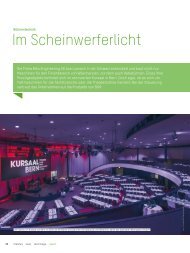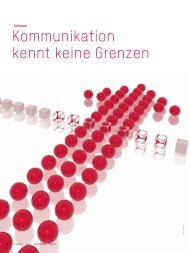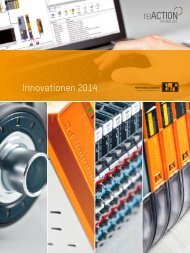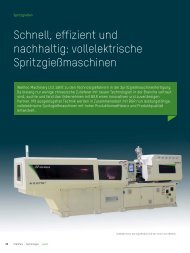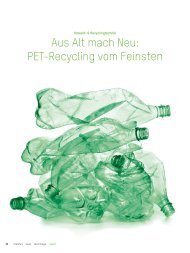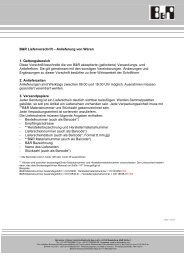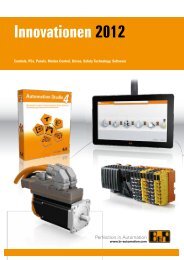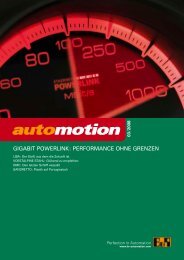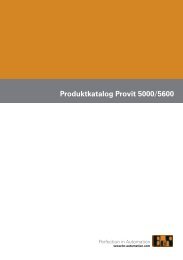automotion automotion automotion automotion - B&R Industrie ...
automotion automotion automotion automotion - B&R Industrie ...
automotion automotion automotion automotion - B&R Industrie ...
You also want an ePaper? Increase the reach of your titles
YUMPU automatically turns print PDFs into web optimized ePapers that Google loves.
of individual plants throughout the<br />
entire complex.<br />
Dr. Bernhard Voglauer, managing<br />
control technician in the Lenzing Fibers<br />
technical planning department<br />
found himself confronted with just<br />
this back in 2006. In-house chemists<br />
developed and tested a completely<br />
new process in the laboratory, which<br />
proved to be effective. the goal now<br />
was to implement the results in a<br />
full-scale production system. Construction<br />
of the system was mostly<br />
finished and a general automation<br />
concept had already been created.<br />
even the decision for the process<br />
control technology which would be<br />
used had already been made. the<br />
automation engineers at Lenzing<br />
count on B&R's ApROL for this.<br />
Because the production processes<br />
in this sort of system are complex<br />
and are not entirely hazard-free due<br />
to the chemical processes used, it<br />
is common to build a so-called pilot<br />
system after lab testing and before<br />
construction of the full-scale<br />
system. the pilot system is used to<br />
test and optimize processes scaled<br />
down to kilograms, before they are<br />
applied to the full-scale system. It is<br />
not hard to see how this procedure<br />
can consume a good deal of investment,<br />
time and space. "this drove<br />
us to search for a solution that didn't<br />
require this cumbersome intermediate<br />
step," remembers Bernhard Vo-<br />
glauer. "It was clear that the unproductive<br />
time spent on optimization<br />
during the commissioning phase<br />
was not acceptable."<br />
Safety through simulation<br />
Bernhard Voglauer found the answer<br />
to this challenging task to be<br />
dynamic process simulation, in<br />
Application<br />
The production chain goes from the sustainable raw material wood to the finished fiber.<br />
which the entire production system,<br />
including all process data, is simulated<br />
as a computer model. In this<br />
way, optimization can be performed<br />
on a virtual system. Without production<br />
downtime, without substandard<br />
production and most importantly<br />
without endangering the workers,<br />
the machine or the environment.<br />
As a tool, mAtLAB ® /Simulink ® from<br />
the American manufacturer the<br />
mathWorks was an obvious choice.<br />
On the one hand, because it is a<br />
well-known simulation system used<br />
worldwide that, unlike the product<br />
used earlier by Lenzing Ag, can<br />
handle the required complexity. On<br />
the other hand, because code that is<br />
understood by B&R systems such as<br />
the ApROL process control system<br />
The savings achieved by shortening the<br />
commissioning time for large systems from<br />
weeks to days are enormous.<br />
can be generated directly from the<br />
simulation models.<br />
With respect to the expected benefits<br />
brought by dynamic simulation<br />
of production systems, Bernhard Voglauer<br />
says: "The economic benefits<br />
are a result of being able to start production<br />
at full capacity sooner, with<br />
“Through simulation with MATLAB ® /Simulink<br />
® we were able to shorten the commissioning<br />
time of a new production system to<br />
a minimum. The time saved and the problems<br />
avoided through virtual commissioning<br />
convinced even the toughest critics.“<br />
Dr. Bernhard Voglauer<br />
Managing Control Technician<br />
Faser Lenzing Technik Planung<br />
minimum time lost during commissioning."<br />
Predefined settings for PCS<br />
parameters such as operating points,<br />
limit values, closed loop control parameters,<br />
alarm limits, etc. also contribute<br />
to the control concept and<br />
operability as does the detection of<br />
errors/defects in the pCS programming.<br />
In addition, the plausibility of<br />
the process design can be checked,<br />
and acceptance by the system operators<br />
can be increased by providing<br />
training in advance and implementing<br />
impressive functionality, which is<br />
important for smooth operation.<br />
Over the course of three months and<br />
nearly 400 hours of work, a physical<br />
model and then the Simulink simulation<br />
model were created based<br />
on construction data, the process<br />
graphic, expert knowledge and the<br />
results of lab testing.<br />
the "hardware-in-the-loop" concept<br />
was used: the simulation model >><br />
<strong>automotion</strong> 07/2009<br />
53



